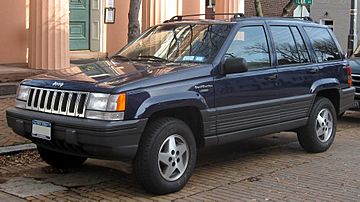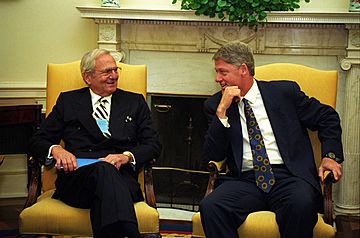Lee Iacocca facts for kids
Quick facts for kids
Lee Iacocca
|
|
|---|---|

Iacocca in 1972
|
|
| Born |
Lido Anthony Iacocca
October 15, 1924 Allentown, Pennsylvania, U.S.
|
| Died | July 2, 2019 (aged 94) Los Angeles, California, U.S.
|
| Alma mater | |
| Occupation | |
| Years active | 1946–1992 |
| Spouse(s) |
|
| Children | 2 |
Lido Anthony "Lee" Iacocca (/ˌaɪ.əˈkoʊkə/ EYE-ə-KOH-kə; October 15, 1924 – July 2, 2019) was a famous American businessman in the car industry. He was best known for helping create the popular Ford Mustang car. He also became famous for saving the Chrysler Corporation from going out of business in the 1980s.
Iacocca was the president and CEO of Chrysler from 1978, and chairman from 1979, until he retired in 1992. He was one of the few leaders to run two of America's biggest car companies, Ford and Chrysler. He also wrote or helped write several books, including his autobiography, Iacocca: An Autobiography.
Contents
Early Life and Education
Lee Iacocca was born in Allentown, Pennsylvania. His parents, Nicola and Antonietta, were Italian Americans who came from Italy and settled in Pennsylvania. His family owned a restaurant called Yocco's Hot Dogs, which is still open today.
Iacocca graduated from William Allen High School in 1942. He then went to Lehigh University, where he studied industrial engineering. After Lehigh, he earned a master's degree in mechanical engineering from Princeton University in 1946.
Right after college, Iacocca started his career at the Ford Motor Company. He first worked as an engineer there.
Working at Ford Motor Company (1946-1978)

Lee Iacocca joined the Ford Motor Company in August 1946. He soon moved from engineering to sales and marketing, where he did very well. While working in Philadelphia, he became known for his "56 for '56" sales plan. This plan let people buy 1956 cars with a small down payment and $56 monthly payments for three years.
His idea became popular across the country. Iacocca was called to Ford's main office in Dearborn, Michigan, and quickly moved up the ranks. He became a vice-president in 1960 and the president of Ford Motor Company in 1970.
Iacocca helped design many successful Ford cars, like the Ford Mustang and the Lincoln Continental Mark III. He also helped bring back the Mercury brand. He even convinced Henry Ford II, the company boss, to get Ford back into car racing. Ford then won several big races like the Indianapolis 500 and the 24 Hours of Le Mans.
Even though he was president and the company was making a lot of money, Iacocca often disagreed with Henry Ford II. Because of these disagreements, he was fired from Ford on July 13, 1978.
The Ford Pinto Car
In 1968, Iacocca saw that people would soon want smaller, fuel-efficient cars. He suggested making a car that weighed less than 2,000 pounds and cost less than $2,000. This idea led to the creation of the Ford Pinto, which started being made in 1971. Iacocca was a key person behind the Pinto's development.
Later, in 1977, there were concerns that the Pinto's fuel tank could be easily damaged in a rear-end collision, which could lead to fires. This situation is often studied in engineering classes as an example of how not to balance costs and safety. In 1978, Ford recalled all Pintos made between 1971 and 1976 to add safety parts to protect the fuel tank.
Leading Chrysler (1978-1992)
After leaving Ford, Iacocca was asked to join Chrysler. At the time, Chrysler was in big trouble and almost going out of business. Iacocca joined Chrysler and started to rebuild the company. He brought in many people he had worked with at Ford.
Iacocca also brought an idea from Ford called the "Mini-Max" project. This project led to the very successful Dodge Caravan and Plymouth Voyager minivans, which came out in 1983. Henry Ford II had not wanted to make a minivan at Ford, but Iacocca and his team believed in the idea.
Iacocca arrived at Chrysler shortly after they introduced the small Dodge Omni and Plymouth Horizon cars. These front-wheel-drive cars were very popular, selling over 300,000 units each in their first year. This showed that Chrysler could make cars people wanted.
Saving Chrysler in 1979
Iacocca realized that Chrysler needed a lot of money to survive. In 1979, he went to the United States Congress and successfully asked for a special loan guarantee from the government. To get this help, Chrysler had to cut costs and stop some projects, like their special turbine engine.
In 1981, Chrysler released the first of its "K-Car" line, the Dodge Aries and Plymouth Reliant. These small, efficient, and affordable front-wheel drive cars sold very quickly, even during a tough economic time.
Chrysler then introduced the minivan in late 1983. This vehicle became incredibly popular and led the car industry in sales for 25 years! Because of the K-cars and minivans, and the changes Iacocca made, Chrysler quickly became profitable again. The company was even able to pay back its government loans seven years earlier than expected.

Iacocca also led Chrysler to buy AMC in 1987. This deal brought the very profitable Jeep division under Chrysler's control. AMC had already done most of the work on the Jeep Grand Cherokee, which Iacocca really wanted. The Grand Cherokee was released in 1992, the same year Iacocca retired.
Throughout the 1980s, Iacocca became famous for appearing in Chrysler's TV commercials. He used the slogan, "The pride is back," to show how the company had turned around. He also said his famous line: "If you can find a better car, buy it."
Lee Iacocca retired from Chrysler at the end of 1992.
Later Involvement with Chrysler
In 1995, Iacocca helped a billionaire named Kirk Kerkorian try to take over Chrysler. This attempt was not successful. Later, in 2005, Iacocca returned to TV ads for Chrysler, promoting a special sales program. He donated his earnings from these ads, plus a donation from each car sold, to his foundation for type 1 diabetes research.
In 2009, Chrysler faced bankruptcy. Iacocca lost part of his retirement benefits because of this. The company was eventually sold to a new group, including the United Auto Workers union, the Italian carmaker Fiat, and the governments of the United States and Canada.
Other Work and Activities
Books Written by Iacocca
In 1984, Iacocca wrote his autobiography, Iacocca: An Autobiography, with William Novak. It was a huge bestseller in 1984 and 1985. Iacocca gave all the money he earned from the book to research for type 1 diabetes.
He also co-wrote Talking Straight in 1988, which talked about American innovation. In 2007, he published another book called Where Have All the Leaders Gone?.
Businesses and Investments
Iacocca invested in different businesses after leaving Chrysler. He joined the board of MGM Grand Inc. and started a bank to fund projects in the gaming (casino) industry. He also invested in Native American gaming projects.
In 1993, Iacocca started Olivio Premium Products, which made food products using olive oil. He even appeared in commercials for Olivio. He also joined the board of a restaurant chain called Koo Koo Roo.
In 1997, Iacocca founded Iacocca, a company that made and sold electric bikes. These bikes could go up to 15 mph and travel 20 miles on one charge.
Helping Others and Giving Back
After his first wife, Mary, died from type 1 diabetes, Iacocca became a strong supporter of research for this disease. He founded Olivio Premium Products and gave all its profits to diabetes research. He also started a campaign called "Join Lee Now" to help fund research for human clinical trials.
In 1982, President Ronald Reagan asked Iacocca to lead the Statue of Liberty-Ellis Island Foundation. This group raised money to restore the Statue of Liberty and renovate Ellis Island. Iacocca continued to be involved with this foundation until his death.
Iacocca also helped raise money for Lehigh University, his old college. He helped them use old buildings from Bethlehem Steel for new university programs. One of these buildings is now called Iacocca Hall.
Acting Role
Lee Iacocca even had a small acting role! He played a character named Park Commissioner Lido in an episode of the TV show Miami Vice in 1986. Lido was his birth name.
Personal Life
Family and Marriages
Iacocca married Mary McCleary on September 29, 1956. They had two daughters. Sadly, Mary Iacocca died from type 1 diabetes in 1983. After her death, Iacocca became a very active supporter of research to find a cure for the disease.
He married Peggy Johnson in 1986, but their marriage was ended after 19 months. He married for a third time in 1991 to Darrien Earle, but they divorced three years later.
Later Years and Passing
In his later years, Iacocca lived in Los Angeles. He passed away at his home on July 2, 2019, at the age of 94. He died from problems related to Parkinson's disease. He was buried in Troy, Michigan.
Politics

In his 2007 book, Iacocca shared that he thought about running for president in 1988. Polls at the time showed he had a good chance of winning, but his friend Tip O'Neill convinced him not to run.
He was also asked if he wanted to be a U.S. Senator for Pennsylvania in 1991, but he said no.
Iacocca supported different political parties over the years. He supported the Republican candidate George W. Bush in the 2000 presidential election. But in the 2004 election, he supported the Democrat John Kerry. In 2012, he supported Mitt Romney for president.
In 2007, Iacocca started a website to encourage people to talk about important issues like healthcare and developing new energy sources. He also used the site to promote his book.
Awards
In 1985, Lee Iacocca received the S. Roger Horchow Award. This award is given each year for the greatest public service by a private citizen.
Images for kids
-
Iacocca helped create the famous Ford Mustang. This picture shows a 1965 Mustang convertible, one of the first models.
-
Iacocca wanted the Jeep Grand Cherokee design. This led to Chrysler buying American Motors Corporation in 1987.
-
Iacocca meets with President Bill Clinton in 1993.
See also
 In Spanish: Lee Iacocca para niños
In Spanish: Lee Iacocca para niños







